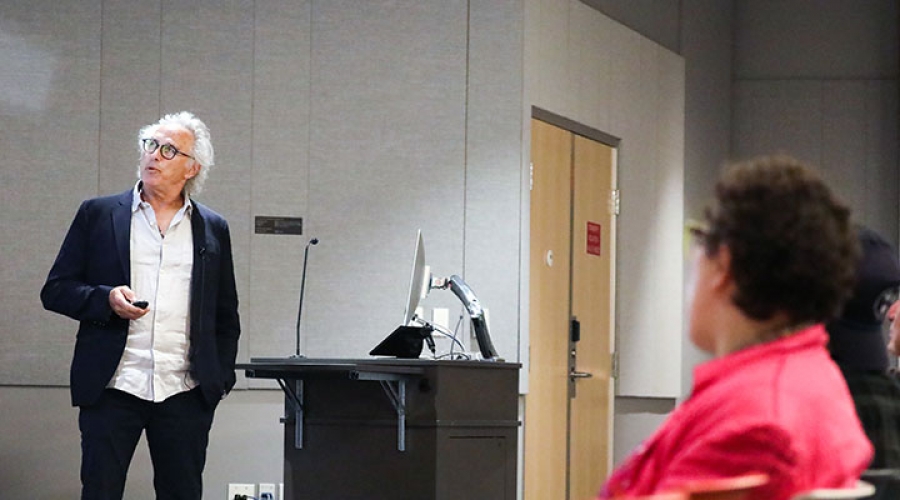
One of the most influential figurative painters of our time, Eric Fischl, kicked off the Otis College of Art and Design Figurative Summer Residency program with a keynote lecture that covered his personal generative process. Fischl’s keynote lecture also provided a brief retrospective to some of his most important and influential works, moving through his work on glassine paper, to his panel murals, through his use of photography and Photoshop and later artworks, and included notes on his landmark 1981 painting, “Bad Boy.” In the keynote lecture, Fischl also covered how he constructs narrative in his paintings, as well as his personal key for realizing when a piece is complete.
Eric Fischl is an internationally acclaimed American painter and sculptor. His artwork is represented in many distinguished museums throughout the world as well as prestigious private and corporate collections, including The Metropolitan Museum of Art, The Whitney Museum of American Art, The Museum of Modem Art in New York City, The Museum of Contemporary Art in Los Angeles, St. Louis Art Museum, Louisiana Museum of Art in Denmark, Musée Beaubourg in Paris, The Paine Weber Collection, and many others. Fischl has collaborated with other artists and authors, including E.L. Doctorow, Allen Ginsberg, Jamaica Kincaid, Jerry Saltz and Frederic Tuten.
His extraordinary achievements throughout his career have made him one of the most influential figurative painters of the late 20th and early 21st centuries. Eric Fischl is a Fellow at both the American Academy of Arts and Letters and the American Academy of Arts and Science, and a Senior Critic and Board Member at the New York Academy of Art. He lives and works in Sag Harbor, NY with his wife, the painter April Gornik.
Process starts with the right materials, and the right questions
For Fischl, finding his mode of artistic expression begins with a process centering on the materials. Artists know that they’ve found the right material for their mode of expression when the material unlocks something within them, Fischl said. For him, that first unlocking came through glassine paper. Another aspect of Fischl’s process involves asking questions of the work, once something is on the glassine: Where are you? What room are you in? Who is with you? By answering these questions, Fischl is able to refine both the work and his own creative vision within the work.
Fischl also covered his use of narrative within his artwork, arising both from answering the questions as well as his use of photography as a model for his painted figures. Fischl said that he would tell himself stories through the use of Photoshop and collage of photographs he found interesting, which taught him to create narrative in the paintings he would later draw from the photographic source material. Fischl talked about his use of diptych panels to create narrative through time, often putting two diptychs side by side that look like they might take place in the same space at different times, or two close spaces at the same time.
“I used to think the problems that painting caused me would open up [in time] and then I’d just fly,” Fischl said, adding that hasn’t exactly been the case. “It turns out the questions [of knowing when your artwork is complete or how to achieve the effect you’re looking for] get harder to answer,” he said. But Fischl said that his rule of thumb for knowing when his artwork is complete is when he turns from creator to the audience of the piece. When he can stand back and look at the piece, and wonder at the coherence and narrative of the piece himself: that’s when he has finished.
Join Otis College for more artistic programming this summer
Summer Residencies and Programs at Otis College offer artists and designers the opportunity to explore and create work in the unique and culturally diverse arts community of Los Angeles. Our programs engage participants in challenging work alongside peers and colleagues who share the same creative goals and passion. Summer 2018 programs include traditional residencies in art, design, and writing; youth and adult intensive classes and camps; theory and practice-based courses; curatorial tracks; and professional development retreats.
Halley Sutton is a graduate of the Otis College of Art and Design MFA Writing program. She lives in Playa del Rey, CA.


